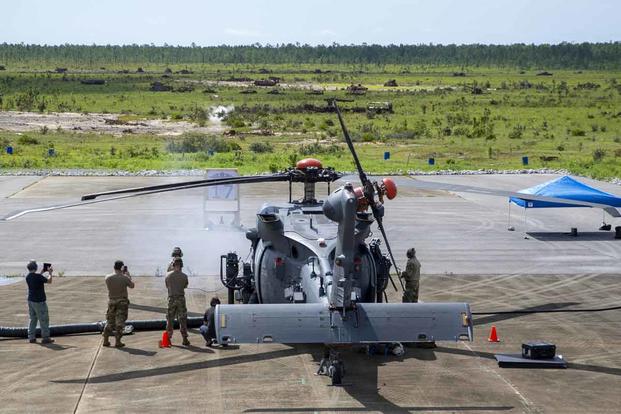The Air Force's new HH-60W combat rescue helicopter, known as the "Jolly Green II," has begun live-fire ground testing, the service said this week.
Airmen with the 413th Flight Test Squadron at Eglin Air Force Base, Florida, recently fired the aircraft's three primary weapons: the GAU-2, a 7.62mm gatling gun with a 3,000 rounds per minute fire rate; the GAU-18, a .50 caliber machine gun with a 650 to 800 round fire rate; and the GAU-21, a newly designed .50 caliber machine gun with a 950 to 1,100 round fire rate, according to a service release.
Read Next: RBG’s Trainer, Army Vet Bryant Johson, Does Push-Ups in Front of Her Casket
All of the ground testing was done using the unit's first "Whiskey 1" model, made by Lockheed Martin company Sikorsky. Each of the weapons is interchangeable via the helicopter's adaptable gun mount system, according to AirMed&Rescue Magazine.
The Whiskey 1 "contains specialized test instrumentation that allows Sikorsky to monitor hundreds of parameters during the flights and envelope expansion testing," according to the release. "That specialized instrumentation allowed the testers to record the stress and strains in the aircraft caused by firing the weapons."
The three tests -- which spanned a three-week period on Eglin's expansive test ranges -- follow other programmatic milestones such as aerial refueling and radar, weather and defensive system testing, officials said.
"It was great to see all the team's planning and hard work finally pay off to get us to execution and gather this initial live-fire data," Maj. Christopher Hull, 413th FLTS chief test engineer, said in the release.
Jolly Green II crews were part of the testing to see how the gunfire affected their ability to conduct a prospective mission -- specifically, whether the blasts have the potential to harm operators or inflict traumatic brain injury symptoms, the release states.
The Air Force's Non-Nuclear Munitions Safety Board will evaluate the findings from the ground tests in coming weeks before deciding whether to clear the helicopter for in-flight ammunition tests, which are expected sometime before the end of the year.
Last year, the service began the first tests on the HH-60W, which is based on the UH-60M Black Hawk and is meant to replace its HH-60G Pave Hawk fleet.
In February, the Air Force unveiled the helicopter's official name during the opening ceremony of the Air Warfare Symposium in Orlando, Florida.
"Reviving the Jolly Green name honors our combat search-and-rescue [CSAR] crews past and present," Air Force Secretary Barbara Barrett said while standing alongside CSAR pilots from past and current conflicts. "In the hands of our airmen, the HH-60W ensures the rescue community can perform their duties better than ever."
The rescue community's motto is, "These things we do that others may live."
The name Jolly Green -- which the CSAR community has adopted as its trademark alongside signature green feet stamped on the aircraft -- dates back to the Vietnam War, when American pilots flew the HH-3E helicopter.
While today's pilots will stamp the sides of the helicopter with green feet to commemorate their own missions, the symbol's origin is a nod to the HH-3E, also known as the Jolly Green Giant, which left fat imprints when landing in Vietnam's rice patties and grass fields, according to the service.
Unlike the new HH-60W, which will officially be known as "Jolly Green II," the HH-3E, used mainly for recovering downed pilots, carried the moniker only as a nickname.
Current 1980s-era HH-60G models are capable of low-altitude operations and have a retractable in-flight refueling probe and internal auxiliary fuel tanks that allow for better range and loiter time during rescue missions.
The HH-60W doubles the internal fuel capacity of the HH-60G model without using auxiliary fuel tanks and increases the flight hours. The aircraft also has improved avionics, navigation and communications and an enhanced software network, plus better defensive measures and armored plating, according to Sikorsky.
The new helicopter's missions include "civil search and rescue, medical evacuation, disaster response, humanitarian assistance, security cooperation/aviation advisory, NASA space flight support and CSAR command and control," per the Air Force.
Through its fiscal 2019 and 2020 budgets, Congress gave the Air Force the authority to procure 22 of the Jolly Green II. The first two units to field the aircraft will be the 41st Rescue Squadron at Moody Air Force Base, Georgia, and the 512th Rescue Squadron at Kirtland Air Force Base, New Mexico.
The service plans to purchase up to 113 of the rotary-wing aircraft.
-- Oriana Pawlyk can be reached at oriana.pawlyk@military.com. Follow her on Twitter at @Oriana0214.
Related: In Vietnam-Era Throwback, New Air Force Rescue Helo Is the 'Jolly Green II'












